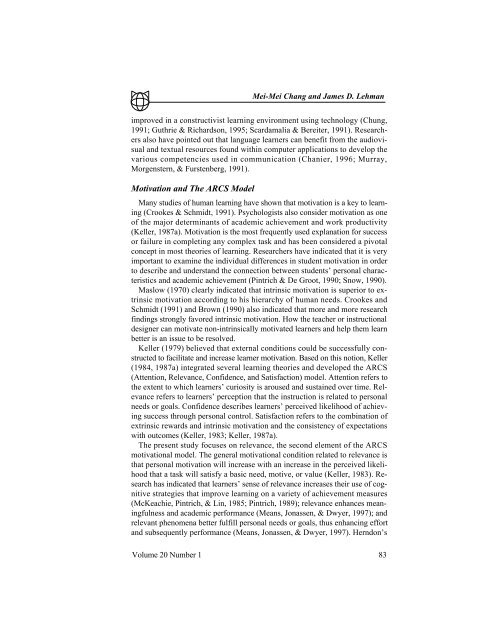Learning Foreign Language through an Interactive Multimedia ...
Learning Foreign Language through an Interactive Multimedia ...
Learning Foreign Language through an Interactive Multimedia ...
Create successful ePaper yourself
Turn your PDF publications into a flip-book with our unique Google optimized e-Paper software.
Mei-Mei Ch<strong>an</strong>g <strong>an</strong>d James D. Lehm<strong>an</strong><br />
improved in a constructivist learning environment using technology (Chung,<br />
1991; Guthrie & Richardson, 1995; Scardamalia & Bereiter, 1991). Researchers<br />
also have pointed out that l<strong>an</strong>guage learners c<strong>an</strong> benefit from the audiovisual<br />
<strong>an</strong>d textual resources found within computer applications to develop the<br />
various competencies used in communication (Ch<strong>an</strong>ier, 1996; Murray,<br />
Morgenstern, & Furstenberg, 1991).<br />
Motivation <strong>an</strong>d The ARCS Model<br />
M<strong>an</strong>y studies of hum<strong>an</strong> learning have shown that motivation is a key to learning<br />
(Crookes & Schmidt, 1991). Psychologists also consider motivation as one<br />
of the major determin<strong>an</strong>ts of academic achievement <strong>an</strong>d work productivity<br />
(Keller, 1987a). Motivation is the most frequently used expl<strong>an</strong>ation for success<br />
or failure in completing <strong>an</strong>y complex task <strong>an</strong>d has been considered a pivotal<br />
concept in most theories of learning. Researchers have indicated that it is very<br />
import<strong>an</strong>t to examine the individual differences in student motivation in order<br />
to describe <strong>an</strong>d underst<strong>an</strong>d the connection between students’ personal characteristics<br />
<strong>an</strong>d academic achievement (Pintrich & De Groot, 1990; Snow, 1990).<br />
Maslow (1970) clearly indicated that intrinsic motivation is superior to extrinsic<br />
motivation according to his hierarchy of hum<strong>an</strong> needs. Crookes <strong>an</strong>d<br />
Schmidt (1991) <strong>an</strong>d Brown (1990) also indicated that more <strong>an</strong>d more research<br />
findings strongly favored intrinsic motivation. How the teacher or instructional<br />
designer c<strong>an</strong> motivate non-intrinsically motivated learners <strong>an</strong>d help them learn<br />
better is <strong>an</strong> issue to be resolved.<br />
Keller (1979) believed that external conditions could be successfully constructed<br />
to facilitate <strong>an</strong>d increase learner motivation. Based on this notion, Keller<br />
(1984, 1987a) integrated several learning theories <strong>an</strong>d developed the ARCS<br />
(Attention, Relev<strong>an</strong>ce, Confidence, <strong>an</strong>d Satisfaction) model. Attention refers to<br />
the extent to which learners’ curiosity is aroused <strong>an</strong>d sustained over time. Relev<strong>an</strong>ce<br />
refers to learners’ perception that the instruction is related to personal<br />
needs or goals. Confidence describes learners’ perceived likelihood of achieving<br />
success <strong>through</strong> personal control. Satisfaction refers to the combination of<br />
extrinsic rewards <strong>an</strong>d intrinsic motivation <strong>an</strong>d the consistency of expectations<br />
with outcomes (Keller, 1983; Keller, 1987a).<br />
The present study focuses on relev<strong>an</strong>ce, the second element of the ARCS<br />
motivational model. The general motivational condition related to relev<strong>an</strong>ce is<br />
that personal motivation will increase with <strong>an</strong> increase in the perceived likelihood<br />
that a task will satisfy a basic need, motive, or value (Keller, 1983). Research<br />
has indicated that learners’ sense of relev<strong>an</strong>ce increases their use of cognitive<br />
strategies that improve learning on a variety of achievement measures<br />
(McKeachie, Pintrich, & Lin, 1985; Pintrich, 1989); relev<strong>an</strong>ce enh<strong>an</strong>ces me<strong>an</strong>ingfulness<br />
<strong>an</strong>d academic perform<strong>an</strong>ce (Me<strong>an</strong>s, Jonassen, & Dwyer, 1997); <strong>an</strong>d<br />
relev<strong>an</strong>t phenomena better fulfill personal needs or goals, thus enh<strong>an</strong>cing effort<br />
<strong>an</strong>d subsequently perform<strong>an</strong>ce (Me<strong>an</strong>s, Jonassen, & Dwyer, 1997). Herndon’s<br />
Volume 20 Number 1 83
















